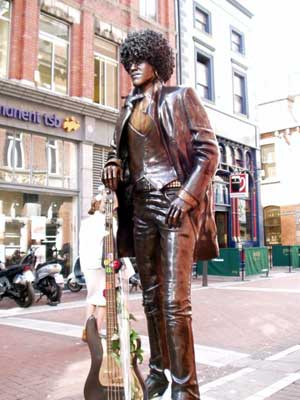John Powell: His Racial and Cultural IdeologiesPosted in Articles, Arts, Biography, History, Media Archive, Politics/Public Policy, United States, Virginia on 2011-07-13 03:09Z by Steven |
John Powell: His Racial and Cultural Ideologies
Min-Ad: Israel Studies in Musicology Online
Volume 5, Issue 1 (2006)
14 pages
David Z. Kushner, Professor Emeritus of Musicology/Music History
University of Florida
The opening of the first movement of the Symphony in A Major “Virginia Symphony” (Allegro non troppo ma con brio). QuickTime-format, WindowsMedia-format
Following John Powell’s death on August 15, 1963, Virginius Dabney closed his editorial comments in the Richmond Times-Dispatch with the following encomium: “Mr. Powell’s passing at 80 removes one of the genuinely great Virginians of modern times. In personality and character he was truly exceptional, and as a pianist and composer he was unique in the annals of the Old Dominion.” Only a dozen years earlier, on November 5, 1951, the then Governor of Virginia, John S. Battle, proclaimed a “John Powell Day,” on which the National Symphony Orchestra under the direction of Howard Mitchell performed the composer’s Symphony in A major. The Governor went on to state that the state-wide tribute to Powell was only fitting owing to “his many contributions to the cultural life of America….” The irregularity of such an extravagant gesture toward a musician in this country had the effect of rejuvenating interest in the artist both within the borders of Virginia and beyond. The world of academia, for example, contributed three master’s theses and a doctoral dissertation between 1968 and 1973, and Radford College, now Radford University, named its new music building Powell Hall at dedication ceremonies held on May 13, 1968.
By the 1950s and 1960s, Powell’s earlier involvement in contentious issues such as race relations in general, and the incorporation of racial and ethnic elements in the formation of an identifiably American music was conveniently forgotten or, at the least, placed on a back burner…
…Fame and, to some extent, fortune permitted Powell to devote more of his energy toward what became the leit motifs of his life—a preoccupation with racial purity and a conviction that Anglo-Saxon folksong serve as the primary basis for an identifiably American music. During the 1920s, Powell developed a friendship with Daniel Gregory Mason, a relationship that is treated in the latter’s book, Music in My Time. Both composers held an aversion to the avant-garde music of their day and both supported the idea that an Anglo-Saxon-based musical aesthetic was the best way to establish an identifiably American music. But Powell’s persona is well-illustrated by the following remarks by Mason:
Considering how insatiably social John is, it is strange how hard it is to extract a letter from him. In all our long friendship I have accumulated only about half a dozen. He will gladly sit up all night with you, if you will let him, discussing music, or just gossiping—for he has an unappeasable appetite for personalia, especially when spiced with a little friendly malice—or declaiming on some of his pet fanaticisms such as the horrible dangers of intermarriage between Negroes and whites, or the supreme virtues of Anglo-Saxon folk-songs…
…Where Mason’s biases were slanted toward Jews, Powell’s were directed primarily, but not exclusively, to blacks. And these prejudices were, like Mason’s, intertwined with his views on the state of American music. In September 1922, Powell and several prominent Virginians of like thinking, was a founder of the Anglo-Saxon Clubs of America, the purpose of which was to foster “the preservation and maintenance of Anglo-Saxon ideals and civilization in America. This purpose is to be accomplished in three ways: first, by the strengthening of Anglo-Saxon instincts, traditions, and principles among representatives of our original American stock; second, by intelligent selection and exclusion of immigrants; and third, by fundamental and final solutions of our racial problems in general, most especially of the negro (sic) problem.” The pamphlet further enact legislation that will ensure the preservation of the white race:
- There shall be instituted immediately a system of registration and birth certificates showing the racial composition (white, black, brown, yellow, red) of every resident of this State.
- No marriage license shall be granted save upon presentation and attestation under oath by both parties of said registration or birth certificates.
- White persons may marry only whites.
- For the purposes of this legislation, the term “white persons” shall apply only to individuals who have no trace whatsoever of any blood other than Caucasian.
Aligning himself with leaders of the burgeoning eugenics movement, Powell was instrumental in gaining political support for passage of the Racial Integrity Act, which was signed into law on March 20, 1924 by the Governor of Virginia, Elbert Lee Trinkle. This bill also forbade the marriage of Orientals and other non-whites to whites, although the compulsory registration provision was defeated…
…Powell makes clear the direction in which he is heading, by decrying the likelihood of miscegenation and by citing specifically “the negro (sic) problem”:
If the present ratio were to remain permanent, the inevitable product of the melting pot would be approximately an octoroon. It should not be necessary to stress the significance of this point. We know that under Mendelian law the African strain is hereditarily predominant. In other words, one drop of negro (sic) blood makes the negro (sic). We also know that no higher race has ever been able to preserve its culture, to prevent decay and eventual degeneracy when tainted, even slightly, with negro (sic) blood. Sixty centuries of history establish this rule. Since the first page of recorded fact, history can show no exception. Were the American people to become an octoroon race, it would mean their sinking to the level of Haiti and Santo Domingo…
Read the entire article here.

